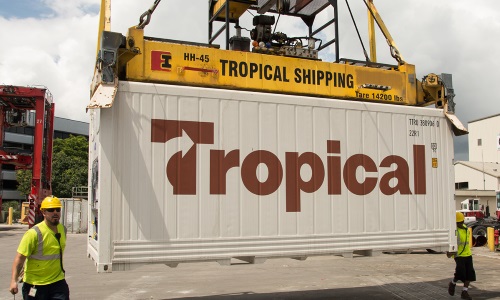
Tropical Shipping has announced that a peak season surcharge will apply to shipments moving between Puerto Rico, the US Virgin Islands, the Bahamas, Belize, the British Virgin Islands, the Cayman Islands, the Dominican Republic, the Leeward Islands, South America, the Windward Islands, and the Turks and Caicos Islands.
The surcharge will be effective for all cargo received from October 5, 2025, through March 1, 2026.
Under the surcharge structure, a 20-foot dry container will carry a fee of US$ 125, while a 40-foot dry container will be subject to US$ 250. Refrigerated equipment will see surcharges of US$ 150 for 20-foot units and US$ 300 for 40-foot units. Containers larger than 40 feet will be charged US$ 281.
For weight and measurement cargo, the surcharge is set at US$ 0.32 per hundredweight and US$ 0.16 per cubic foot.
Vehicles not exceeding 700 cubic feet will incur a fee of US$ 125, while larger vehicles will be charged US$ 6.25 per short or freight ton, the same rate that applies to breakbulk cargo. Barrels will be surcharged at US$ 2.34 each, and pallets at US$ 12.50 each.
Also, surcharge will apply to shipments moving between the Continental US or Canada and the British Virgin Islands, the Leeward Islands, South America, or the Windward Islands, as well as shipments between Canada and the Continental US or Puerto Rico.
Under the surcharge schedule, a 20-foot dry container will be charged US$ 250, while a 40-foot dry container will carry a fee of US$ 500.
For refrigerated containers, the surcharge will be US$ 300 for 20-foot units and US$ 600 for 40-foot units. Containers larger than 40 feet will be subject to a fee of US$ 563.
Cargo calculated by weight or measurement will be charged US$ 0.62 per hundredweight and US$ 0.31 per cubic foot.
Vehicles not exceeding 700 cubic feet will face a surcharge of US$ 250, while larger vehicles will be charged US$ 12.50 per short or freight ton, the same rate applied to breakbulk cargo.
Barrels will carry a surcharge of US$ 4.69 each, and pallets will be charged US$ 25 each.
The company explained that this seasonal surcharge is being introduced to manage the sharp rise in shipping demand during peak months across its service routes.





